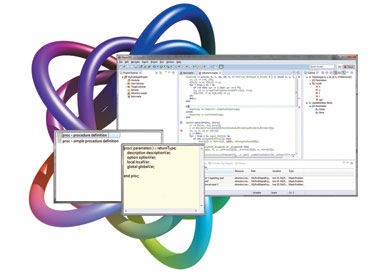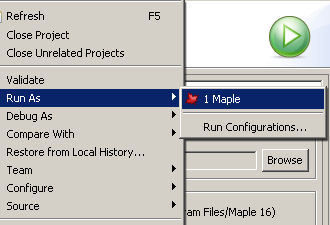Pick of the Week: Maple IDE Reduces Development Time
New development environment can manage projects in Maple language.
Latest News
August 14, 2013
 Maple IDE is a new integrated development environment for the Maple programming language. Image courtesy of Maplesoft. |
The Maple language is the same language available to Maple users for writing scripts, implementing new algorithms, and extending their Maple system. It provides built-in knowledge of mathematical data structures and concepts; support for writing multi-threaded, parallel programs; and a library of commands and algorithms. More than 90 percent of the algorithms built into Maple have been implemented using the Maple programming language, says the company.
Maplesoft says that its new Maple IDE makes it “dramatically easier” for Maple users to create, manage, and update libraries of Maple code. Maple IDE features cited by the company include the ability to quickly browse and search through source hierarchies; automatic highlighting and formatting based on syntactic and semantic properties of the code; navigation; and testing. According to the company, Maple IDE assists developers in writing, updating, maintaining, and understanding code, which can enable projects to be completed faster and with fewer errors. Later enhancements can also be made more easily, adds the company.
Hands-on features include automated refactoring, which enables you to rename Maple elements such as modules, procedures, and variables across all your source files with a single operation; support for syntax coloring and automatic indentation based on the lexical structure and the semantic meaning of the Maple code; and source code validation tools that look for errors and potential problems in your code.
 Maple IDE allows you to run a Maple application from within the IDE itself using Launching Wizards. Image courtesy of Maplesoft. |
Customizable Launching Wizards provide the ability to run a Maple application from within Maple IDE itself. Maple IDE also provides the ability to choose which version of Maple to run if more than one is installed, and you can set up different command-line options. A Content Assist feature lets you select and insert existing code elements to complete partially entered code. Additionally, you can create code templates of commonly used code fragments such as For and While loops, If statements, and procedure definitions.
“Together with our partner DigiArea, we have created a modern development environment on top of the popular Eclipse framework,” said Laurent Bernardin, executive vice president and chief scientist at Maplesoft, in the Maple IDE release announcement. “Maple IDE provides a powerful, familiar environment for seasoned programmers, while giving new programmers valuable assistance getting started.”
Maple IDE requires Maple 17 or Maple 16, and supports Windows, Macintosh, and Linux (32 and 64-bit). A single stand-alone commercial user license is $195, which includes one year of maintenance.
For more details on Maple IDE, visit Maplesoft.
Watch an overview of the Maple IDE.
Go here for more on the key features of the Maple IDE.
See why DE’s editors selected Maple IDE as their Pick of the Week.
Sources: Press materials received from the company and additional information gleaned from the company’s website.
Subscribe to our FREE magazine, FREE email newsletters or both!
Latest News
About the Author
Anthony J. Lockwood is Digital Engineering’s founding editor. He is now retired. Contact him via [email protected].
Follow DE





